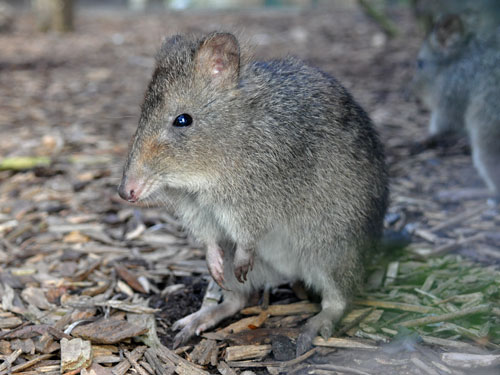
Long-nosed potoroo(Potorous tridactylus)
Phylum —chordata
Class — mammalia
Order — diprotodontia
Family — potoroidae
Genus – potorous
Appearance
At first glance, the Long-nosed potoroo with its pointed nose and grey-brown fur looks very much like a bandicoot — that is, until it hops away with its front feet tucked into its chest, revealing its close relationship with the kangaroo family. The Long-nosed potoroo exhibits many morphological specializations such as an elongated pointed rostral region (nose), erect ears, large eyes, claws for digging, and long robust hind legs. It is only a small marsupial, with a body length between 34 and 38 cm (13–15 in), and a semi-aprehensile tail length of 15 to 24 cm (5.9–9.4 in).
Habitat
Populations of Long-nosed potoroos occur on Tasmania, some of the Bass Strait islands as well as south-eastern coast of Australia, from Queensland to south-eastern South Australia.
Behavior
Long-nosed potoroos are generally solitary. They socialize only when mating or rearing their offspring. In addition, there have been observed loose feeding groups, consisting of several males and females. These potoroos do not display territorial behavior. As nocturnal animals, Long-nosed potoroos spend their daytime hours sheltering in dense vegetation. They come out of their shelters during the night to find food. However, during the winter (particularly on cloudy days), they are known to emerge from their shelters by day. When foraging, potoroos usually make short hops on the forest floor and dig small hollows in the ground to find food. Living in dense vegetation, Long-nosed potoroos create a system of tracks through the undergrowth, which serve as reliable protection from predators.
Diet
The diet of these omnivorous animals primarily consists of fungi, complemented with green vegetation, tubers, seeds, fruits as well as arthropods such as centipedes.
Reproduction
Long-nosed potoroos are polygynandrous (promiscuous): this is when both males and females have multiple mates. They breed all year round with peak periods, occurring in early spring and early summer. Gestation period in this species is the longest among all marsupials - 38 days. Female gives birth to a single baby, which climbs into the pouch of its mother, living there for about 4 months. Weaning occurs by 5-6 months of age, while sexual maturity is reached at one year old.
In captivity
The Long-nosed potoroo can live to 10 years.
The cages should be 120 x 90 x 60 cm in size with a layer of wet sandy soil at the bottom of at least 30 cm, so that the animals can dig the soil. The keeper need to put a litter of dry plants. It is necessary to add a mixture of seeds with leafy greens. Water should be given in a drinking bowl, but Long-nosed potoroos get most of the water they need from food. Never keep more than one Long-nosed potoroo in a cage, otherwise fights will be inevitable.
 Russian
Russian
 English
English
























